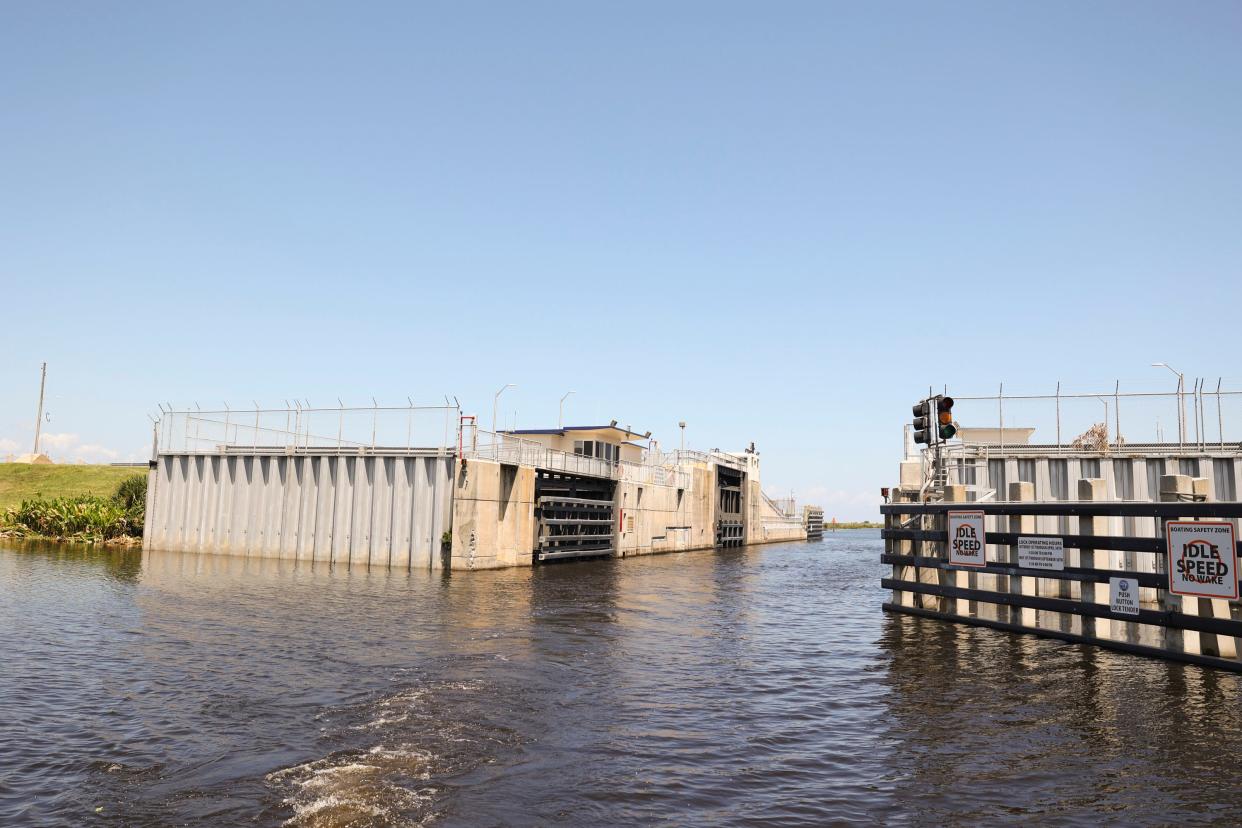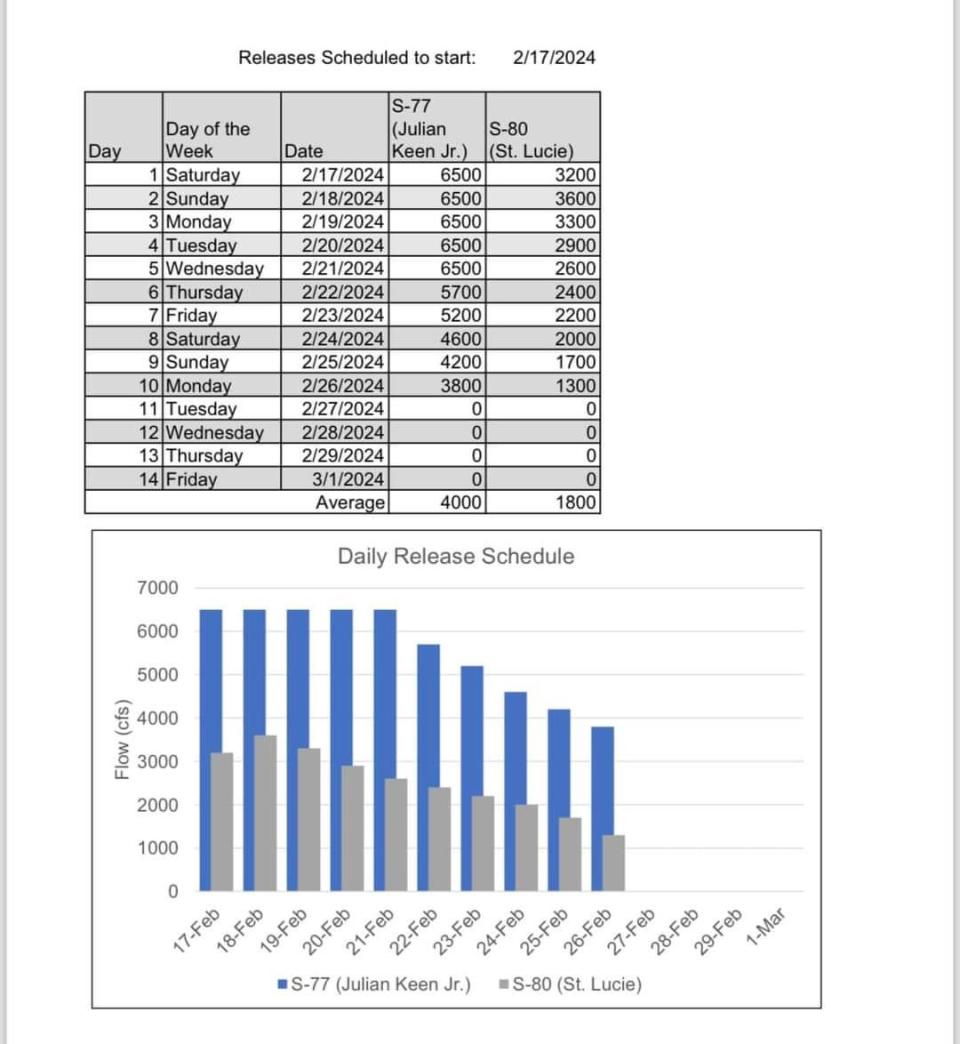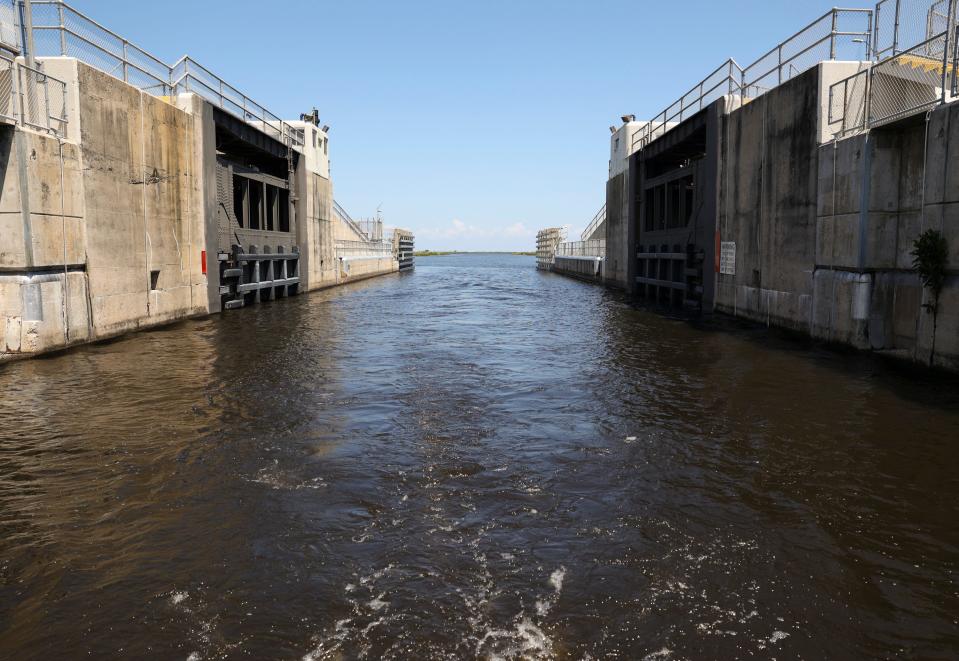Lake Okeechobee discharges coming Saturday; Army Corps says lake too high

The Army Corps of Engineers will begin discharging water from a swollen Lake Okeechobee on Saturday.
According to the Army Corps press release, an estimated:
1.2 billion gallons per day of lake water will pour into the St. Lucie River through the St. Lucie Lock and Dam in west Stuart
2.6 billion gallons per day into the Caloosahatchee River through the Julian Keen Lock and Dam in Moore Haven
323 million gallons per day into the Lake Worth Lagoon through the C-51 canal, according to the Army Corps of Engineers press release.
The discharges will continue for an unknown duration of days. Moving water out of Lake Okeechobee is controlled largely by the Army Corps of Engineers.
What are pulse releases?
One of the main phrases in the Army Corps press release is: "an average of 4,000 cubic feet per second (cfs) at Julian Keen Jr. Lock and Dam (S-77), 1,800 cfs at St. Lucie Lock and Dam (S-80) and up to 500 cfs to the Lake Worth Lagoon through the C-51 canal."
The average is calculated over two weeks. So the discharges will begin at a flow rate higher than 1,800 cfs — at 3,200 cfs the first day, going up to 3,600 cfs the second day and so on until the final four days of the two week period is zero cfs. It's all explained in the chart below.
To some, the way the Corps describes it is misleading to residents along the estuaries.

Why is this happening?
The level of Lake Okeechobee is at 16 feet 4 inches. The level is not the depth of the lake; it's the level of the surface measured approximately against sea level. The depth of the lake is more like 8-10 feet at its deepest.
The lake measures 730 square miles or 467,000 acres in size. Its level can rise as much as 4 inches with 2 inches of rainfall north of the lake in the Kissimmee River basin, which is about 100 miles long and 40 miles wide. Lake Okeechobee, which is about 40 miles wide east to west, is the second largest freshwater lake completely contained within U.S. borders.
For five years, the Army Corps has been working on the Lake Okeechobee System Operating Manual (LOSOM). It will determine how the lake will be managed for years to come. But the Army Corps is discharging water using the Lake Okeechobee Regulation Schedule 2008 (LORS08), established in 2008, when the lake was kept lower to work on re-fortifying the 80-year-old Herbert Hoover Dike. The Corps spent 15 years and $1.6 billion to build a concrete retaining wall deep inside the foot of the dike for 56 miles between Port Mayaca and Moore Haven.
LOSOM is expected to be completed later this year, Maj. Cory Bell told the Rivers Coalition in Stuart on Jan. 18.
"These polluted Lake Okeechobee discharges are especially infuriating because we shouldn't be getting them now. If the new lake management plan, LOSOM, was in effect — as it should be — the Army Corps wouldn't start damaging releases until lake levels were higher. Under LOSOM, the St. Lucie River would not get any lake water until the lake rose above about 16.5 feet in February, and the Caloosahatchee would get about half of what it's being forced to accept," said Eve Samples, executive director of Friends of the Everglades.
The project was completed in January 2023 under budget. It was expedited by former President Donald Trump.
"Unfortunately, bureaucratic wrangling has delayed final approval of LOSOM. Meanwhile, corporate sugarcane growers south of the lake continue to receive near-perfect drainage and irrigation from Lake O," Samples added.
Will any Lake Okeechobee water go south?
Yes. Some water already is being sent down some of the smaller canals that feed irrigation water into the agricultural fields south of Lake Okeechobee. Any water going anywhere other than the estuaries is good.
The main canals that move water south are the Miami Canal, West Palm Beach Canal and Hillsboro/New River Canal. They are about half as large as the C-44 canal that goes from Port Mayaca to the St. Lucie River and the C-43 canal that goes from Moore Haven to Fort Myers. They can't move high volumes of water out of the lake.
As of Feb. 14, 1,667 cfs or 1.1 billion gallons per day are going south through the Miami, Hillsboro/New River and West Palm Beach canals combined, according to data from the South Florida Water Management District.
“We understand the Army Corps’ objective of reducing high water levels in Lake Okeechobee in preparation of the upcoming wet season while there are no Harmful Algal Blooms present on the lake. The South Florida Water Management District is helping reduce lake levels by sending as much water south to the Everglades as possible, while continuing to meet stringent water quality requirements. We encourage the Army Corps to make the decision to also reduce flows from Lake Kissimmee into Lake Okeechobee and fully utilize available capacity in the C-44 Reservoir. It’s also important the downstream estuarine conditions are monitored during this time to guide future decisions.
These events highlight the fact that we need more places to put excess water in our water management system instead of harmfully discharging to our estuaries. That’s why the State of Florida must follow Governor DeSantis’ lead and continue fully funding the Comprehensive Everglades Restoration Plan (CERP) and expedite water storage projects like the EAA Reservoir around Lake Okeechobee. Lake Okeechobee is currently operating under an outdated Lake Okeechobee management plan, and today’s announcement also underscores the importance of implementing the new Lake Okeechobee System Operating Manual (LOSOM).
The District will continue sending as much water south and maximizing storage of water around Lake Okeechobee in an effort to shorten the duration of harmful estuary discharges,” said South Florida Water Management District Chief Communications Officer Sean Cooley.

What will this do to the estuaries?
Nothing good. In the St. Lucie River, the South Fork in Palm City and west Stuart is connected to the canal and Lake Okeechobee at the St. Lucie Lock and Dam. There is a 14-foot drop between the level of the canal and the brackish tidal river below.
As the freshwater influx increases, it will lower the salinity as far downstream as the Roosevelt Bridge in downtown Stuart. The salinity about a week after the discharges begin will begin to near 0 parts per thousand. That is low enough to kill oysters if it remains that low for several weeks. Oysters serve as a natural filtering system for estuaries, cleaning about 50 gallons of water per day.
Farther downstream, and after the discharges continue for a few weeks, the low salinity and tannin-stained water can shade and smother seagrasses in the Indian River Lagoon near Sailfish Point and Sewall's Point. Spring time is when these grasses sprout and grow, creating habitat for a number of marine organisms.
"While we recognize the complexities involved in managing water levels, it is imperative to highlight the ecological consequences such releases pose," said Mark Perry, executive director and CEO of Florida Oceanographic Society in Stuart. "Historically, discharges from Lake Okeechobee have led to significant environmental consequences to the St. Lucie River and Indian River Lagoon, including harmful algal blooms, seagrass die-offs and the destabilization of estuarine ecosystems and our coastal waters. These discharges pose a threat to the delicate balance of our estuaries, upon which countless species depend."
Have spring time discharges happened recently?
Last year was the last time discharges occurred. From Jan. 22 to April 15, 2023, the Army Corps tried to lower the level of Lake Okeechobee. They dropped the water level 1 foot 10 inches in 83 days, dumping 17.3 billion gallons into the St. Lucie River during that time.
More volume was dumped to the Caloosahatchee, but the canal is about 54 miles long while the canal between Port Mayaca and Stuart is 23 miles long.
The reason the Army Corps does this is because the threat of Lake Okeechobee causing problems to the 144-mile-in-circumference Herbert Hoover Dike encircling the lake is dire. Overtopping the dike or causing erosion to it and structural damage is a fear for the communities surrounding the dike.
One tropical storm or hurricane drifting over Central Florida during the rainy season could upset the delicate balance of lake management.
Long time: Ed Killer: Everglades restoration has a long, expensive way to go
Waiting game: Army Corps began new Lake O management plan 5 years ago. What is taking so long?
Many lake advocates do not want the Army Corps to keep the lake above 15 feet for fear the habitat inside the lake will be drowned out. Bassmaster Elite series professional bass angler Scott Martin of Clewiston said it after winning the St. Croix rods tournament last week with a record 90-pound three-day bag limit: "The lake is 467,000 acres. Right now, our fishable water is probably reduced down to 20,000 acres around the lake," Martin told the Lake Okeechobee News on Feb. 6. "We have 0 acres of SAV (submerged aquatic vegetation) left. We have cattails and emergent vegetation, but no SAV."
He told Bassmaster he'd like to see the lake level ideally kept at 13-15 feet 6 inches to manage ideal habitat of native aquatic plants for bass. Duck hunters, bird watchers, lake commercial fishermen agree, and many coastal residents would agree.
Ed Killer covers the outdoors for TCPalm. This is his opinion. Email him at ed.killer@tcpalm.com.
This article originally appeared on Treasure Coast Newspapers: Lake Okeechobee discharges start Saturday. Army Corps: "Lake too high"

